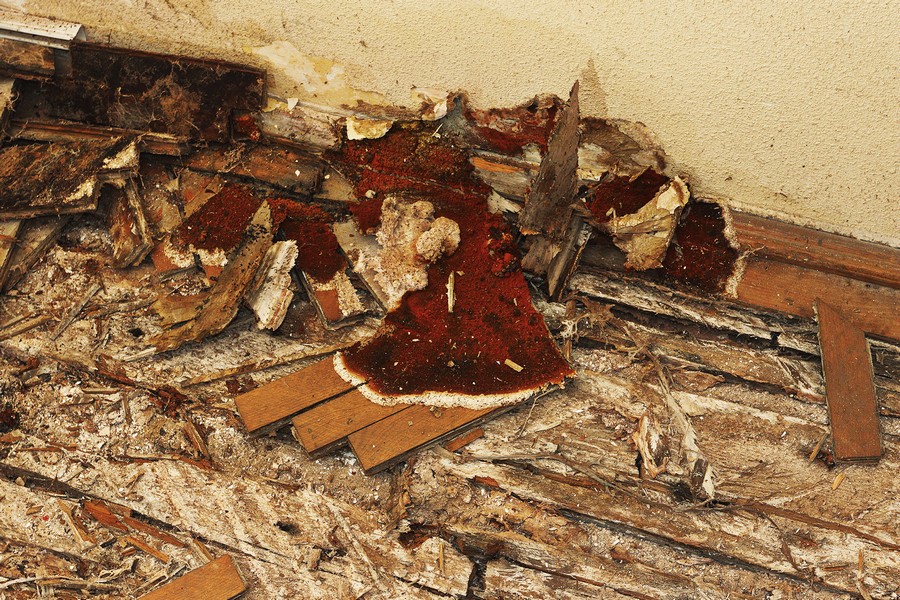Call Our Brighton Damp Experts team now for a free quote, consultation and advice.

Wood is a common material used in homes and structures, yet it needs to be protected from the more serious threats of wet and dry rot.
It’s essential to differentiate between these two varieties of fungal decay as they necessitate distinct treatments. This page will guide you in detecting wet rot and dry rot, along with the various available remedies. Expert diagnosis and treatment are mandatory for both types of decay.
It is imperative to have experts intervene in the matter, as treating dry rot will not suffice for wet rot concerns.
Brighton Damp Treatments can diagnose, identify, repair and treat wet rot and any other damp-related problems. Please contact us on **XX** to arrange a survey with one of our specialists. They will then create an affordable plan to eradicate the issue.

Wet rot is the natural decomposition of wood caused by too much moisture. It takes place in timber that has a humidity level between 30 to 50%, compared to dry rot which happens when the moisture content is below 30%.
Wet rot is caused by fungi that thrive in damp wood, devouring it and eventually destroying it. The most common type of wet rot fungus is Coniophora Puteana, also known as cellar fungus.
High humidity is the root of most damp issues. It can bring about moisture, mould and dampness gathering inside buildings, impinging on masonry, brickwork and wood. Damp signifies an array of troubles triggered by excessive humidity; it is essential to ascertain precisely what is causing the issue and its origin.
If your property has a dampness issue due to condensation, increasing the ventilation may be the answer. For instance, when water leaks through walls because of faulty guttering, it can cause penetrating dampness – an issue which cannot be rectified solely by improved ventilation.
If moisture is noticed only at the bottom of a wall, then it is probable that rising dampness is the cause. This happens when a protective barrier known as a damp-proof course has been damaged, allowing groundwater to enter the building.
A suspected structural fault is the most frequent source of wet rot; it can, however, also be precipitated by a long-term kind of Rising Damp. Timber structures are often damaged by wet rot – an expression used to denote naturally deteriorating wood due to excessive moisture.
Almost any wood in a home can suffer from wet rot, so it’s difficult to spot unless you’re a professional. Dry rot is much worse and should not be confused with wet rot. To ensure your peace of mind, call Brighton Damp Treatments on XX for their specialist team to inspect your property and help resolve any damp issues.
In the absence of visible fungus, changes in wood colour and type/amount of cracks can help you identify wet rot from dry rot. Wet rot is characterised by a musty, damp odour as well as an earthy smell reminiscent of rotting soil; it might be worse than dry rot’s aroma. If any such issues are present on your property, do not hesitate to contact our expert team on **XX** for assistance.
Dry rot in your home is a serious issue that should be tackled promptly. It’s a destructive form of decay that spreads away from the source of moisture and damages wood and other building materials. Wet rot fungus is more frequent than dry rot; however, it’s usually limited to an area. Generally, the deterioration affects the timber nearest to the dampness source. Nevertheless, wet rot shouldn’t be disregarded since it can be as hazardous as dry rot and if left untreated can severely weaken structural timbers.
Serpula lacrymans is the only fungus to cause dry rot, and it’s the most damaging kind of fungal decay in buildings. It can spread across an entire building, compromising its structure. As highlighted earlier, any exposed timber which becomes moist with a moisture content between 20-30% – easily achievable in homes – can be affected by dry rot.

Faulty interior plumbing or penetrating damp caused by faulty render, guttering, or downpipes can cause wet and dry rot. It can spread between wall coverings and beneath flooring without the homeowner’s knowledge, causing significant damage.
Failure to address wet rot can lead to wood deterioration, potentially compromising the safety of those living in the property. In some cases, this may manifest as a soft chipboard floor – uncomfortable though manageable. However, if moisture is allowed to linger on structural timber over an extended period – such as when it’s close to a damp wall or (at) ground level – serious issues could arise due to weakened integrity.
If rot has taken hold, the wood will be spongy and tender, and easily give way when prodded with a sharp object such as a knife or screwdriver. Wood which has cracks running along its grain is usually damp – if you would like more information on treating wet rot, contact Brighton Damp Treatments at **XX** for assistance.
Call Our Brighton Damp Experts team now for a free quote, consultation and advice.
Wet rot is widespread in wet regions where wood has been exposed to moisture. We don’t just fix the damage that wet rot has caused, but we stop it from coming back. The source of the problem must be addressed. To avoid future dampness and ensure that the timber rot does not recur, it’s crucial to determine where the water enters the wood. In some cases, you may need to replace the afflicted timbers. In most cases, however, wet rot may be avoided by treating the wood with a fungicide. Wet rot is treated by the use of a fungicide during the drying out process.
To detect and sterilise fungal growth or hyphae strands, you’ll need to selectively employ a powerful fungicide to water the area with a forceful fungicide. You must also remove and discard any tainted plaster that has been contaminated by strands, for example. Any hazardous wood or trash discovered in voids beneath the floor would have to be removed and burned. You’ll need to use a fungicidal solution to treat the damaged wood.
Don’t wait any longer if you’re not sure where to begin treating your wet rot problems. If you choose a professional company, such as ours at Sussex Damp Experts, you’ll obtain the best results. They are experts in the field of wet rot therapy. We’ll figure out what’s causing the wetness and which areas have been harmed. Please don’t wait any longer to reach us. Pick up the phone and dial 01273 920588.
Wet rot is prevalent in damp areas where wood has been exposed to moisture. We not only remedy the damage it causes, but also prevent its return. To stop further moisture and guarantee that timber rot does not come back, one must identify where water enters the wood. Replacing damaged timbers may be necessary in some cases; however, usually wet rot can be prevented by treating the wood with a fungicide. During drying out, a fungicide should be used to treat wet rot.
To detect and eradicate fungal growth or hyphae strands, deploy a powerful fungicide to water the affected area. Discard any contaminated plaster, as well as hazardous wood or debris found in cavities beneath the floor. Treat damaged wood with a fungicidal solution then burn it.
Our staff will attend your property and address the wet rot issue following a timber survey, agreement of a solution and arrangement of a suitable time with you.
Our expert team will undertake the following procedures to fix your wet rot issue:
1. Remove and replace affected timbers
2. Treat with fungicidal solution
3. Replace dry lining
4. Examine for any other signs of damage
5. Provide guarantee for work completed
We maintain high standards for our damp proofing, re-plastering, wood preservation and inspection services.
Our common tasks include basement tanking, preventing moisture ingress, treating cavity walls, eradicating dry rot/woodworm and controlling condensation.
We provide tailored, proficient and reliable damp proofing treatment and repair services to homes, local authorities, small businesses and commercial properties.
Get in touch today on 01273 920588 to discuss your needs with one of our friendly team members.

Qualified surveyors assess the condition of properties and provide reports. They measure and inspect buildings, checking for any signs of structural damage or safety hazards. Surveyors must possess a degree in surveying or related field, as well as experience in the profession.
Qualified surveyors evaluate properties, producing detailed accounts of their condition. They determine if there are any structural issues or potential safety risks, measuring and inspecting the building to do so. To become a surveyor one needs to have undertaken study into surveying or similar disciplines plus professional experience in this area.


Max and his team have been at our property all week and I really can’t thank them enough for the fantastic job they’ve done on plastering both our walls and ceilings. They have literally transformed the appearance of our house! Not only has Ma…
From start to finish Max has been incredable. His knowledge lin damp proofing is second to none and his team where very clean and polite. The plastered finish was like glass so happy we choose Max Plastering for job.
Lovely bunch of lads left a very neat and clean job. Problem was solved.
Perfect Finnish and all left clean and tidy and no mess. Used Max previously and would not hesitate to ask him carry out more work.
Max, Harvey and Stuart arrived promptly as arranged. Done a great job on our outside rear wall. Work completed to a high standard, removal of all old material and cleaned up after themselves. I am so pleased with the standard of their work they ar…
They turned up on time and carried out the works in a very professional manor leaving the front of the house clean and tidy. Very impressed would definitely recommend.
I have to say that on every level Max (with Stuart and Harvey) did an extremely professional job! They explained what they were going to do, they were polite and courteous and respected that they were coming into our home. The plastering is of the…
I called max and he managed to come around the same day to do a survey. The next day I received an extremely detailed survey compared to any other damp proofer which made me feel very at ease that he was going to do the right job. Max and team tur…
Contact Brighton Damp Treatments Now to Speak With an Expert.